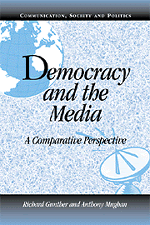Book contents
- Frontmatter
- Contents
- List of Contributors
- Acknowledgments
- 1 The Media in Democratic and Nondemocratic Regimes: A Multilevel Perspective
- 2 The Media and Politics in Spain: From Dictatorship to Democracy
- 3 Institutional Incapacity, the Attentive Public, and Media Pluralism in Russia
- 4 Democratic Transformation and the Mass Media in Hungary: From Stalinism to Democratic Consolidation
- 5 The Modernization of Communications: The Media in the Transition to Democracy in Chile
- 6 Media Influence in the Italian Transition from a Consensual to a Majoritarian Democracy
- 7 The United States: News in a Free-Market Society
- 8 Japan: News and Politics in a Media-Saturated Democracy
- 9 The Netherlands: Media and Politics between Segmented Pluralism and Market Forces
- 10 Great Britain: The End of News at Ten and the Changing News Environment
- 11 Germany: A Society and a Media System in Transition
- 12 The Political Impact of the Media: A Reassessment
- References
- Index
9 - The Netherlands: Media and Politics between Segmented Pluralism and Market Forces
Published online by Cambridge University Press: 05 June 2012
- Frontmatter
- Contents
- List of Contributors
- Acknowledgments
- 1 The Media in Democratic and Nondemocratic Regimes: A Multilevel Perspective
- 2 The Media and Politics in Spain: From Dictatorship to Democracy
- 3 Institutional Incapacity, the Attentive Public, and Media Pluralism in Russia
- 4 Democratic Transformation and the Mass Media in Hungary: From Stalinism to Democratic Consolidation
- 5 The Modernization of Communications: The Media in the Transition to Democracy in Chile
- 6 Media Influence in the Italian Transition from a Consensual to a Majoritarian Democracy
- 7 The United States: News in a Free-Market Society
- 8 Japan: News and Politics in a Media-Saturated Democracy
- 9 The Netherlands: Media and Politics between Segmented Pluralism and Market Forces
- 10 Great Britain: The End of News at Ten and the Changing News Environment
- 11 Germany: A Society and a Media System in Transition
- 12 The Political Impact of the Media: A Reassessment
- References
- Index
Summary
The notion that media and politics influence one another is hardly more than a truism. Of much more interest is the question of the circumstances under which the balance of influence shifts from one side to the other. The Netherlands is an almost exemplary case of how this balance can shift over the course of time.
In the closing decades of the nineteenth century, influence flowed mainly from the political realm to the emerging mass media. The same political conflicts that “pillarized” Dutch society shaped a media system that was to last for the better part of the twentieth century (Daalder 1966; Lorwin 1971). Then, between the late 1920s and the 1960s, influence flowed in both directions as the media and political systems influenced each other and reinforced their respective pillarized characteristics. Since the 1960s, however, the balance has shifted in the other direction, and developments in the media landscape have been cause rather than the consequence of the profound transformations in Dutch society and politics known as “depillarization.” Indeed, starting in the late 1980s, the combination of rapidly developing media technology and the emerging transnational regulatory system of the European Union (EU) undermined the capacity of the Dutch state to influence, let alone shape, how the media system will evolve in the future. To an increasing extent, the world of Dutch mass media has become independent of politics despite the fact that its workings continue to have direct consequences for national political processes and outcomes.
- Type
- Chapter
- Information
- Democracy and the MediaA Comparative Perspective, pp. 303 - 342Publisher: Cambridge University PressPrint publication year: 2000
- 19
- Cited by

